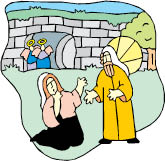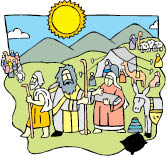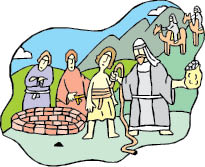One of the interesting challenges to
Christians during the twenty-first century has been the challenge to
the credibility of the Bible. It is interesting that this challenge has
nothing to do with

the existence of God. There are
atheists who seem to think that if somehow they can find a mistake in
the Bible, or a logical inconsistency in what the Bible teaches, they
have proven that God does not exist. The basic arguments for the
existence of God do not involve the Bible. The big question is whether
there is any God, anything out there beyond the physical world that we
can perceive through our five senses. If you have examined the material
presented by this ministry, you have seen that our material supporting
the existence of God does not depend on the Bible. Cosmological,
teleological, ontological, moral, and philosophical proofs of God’s
existence can be made with no appeal to scripture.
By the same token, those of us who have studied the Bible in depth and
with an attempt to be honest with the evidence have seen that there is
good support for the Bible not being the work of ignorant men living in
an ignorant age. Once you admit to the existence of a God—some higher
power, then the next logical set of questions involve which God, what
is that God’s nature? how does that God operate? why did that God
create us? and what would that God have us do to fulfill the purpose
for which we were created? If we are not confident that the Bible is
from God, then we certainly will not allow it to control the way we
make decisions, and this doubt is at the root of much of the immorality
that permeates our society today. We have dealt with this issue
previously in this journal (see
July/August
2003, page 9;
January/February
2006, page 30;
November/December
2006, page 8).
Those who claim the Bible is full of errors, inconsistencies, and
contradictions make six fundamental errors in their challenges to the
credibility of the Bible. We would like to take a look at each of these
errors and see an example or two of each. Atheists’ Web sites and books
are full of examples of things they consider to be errors, but almost
all of them fall into one of these six areas. Before we engage in this
discussion I want to be sure to clarify that I do not have every
question about the Bible answered, nor am I arrogant enough to believe
that I can answer every question that others can ask. By the same
token, the level of ignorance displayed in the attacks being made on
the Bible is very high, and can be answered by anyone who will take the

time to study the claimed errors carefully.
COPYIST ERRORS
DO EXIST. For most of the time the Bible has been in existence,
manuscripts were copied by hand. Many times the words being copied are
very close in appearance, and it is easy to make a mistake in a
handwritten manuscript. The number 4, for example, is
rbh in Hebrew while the number 40
is
rbym. In the King James
translation of 1 Kings 4:26, we are told that Solomon had 12,000
horses. Second Chronicles 9:25 confirms that number, but differs from 1
Kings in how many stalls he had. Second Chronicles says there were
4,000 stalls and 1 Kings says there were 40,000 stalls. Any honest
reader is going to realize that 40,000 stalls for 12,000 horses does
not make much sense. Somewhere in copying there was an error made as
the words
rbym and
rbh were confused. In spite of
these errors, as new copies of manuscripts from the first several
centuries are found, the consistency and accuracy of the copies of the
Bible is remarkable.
READING
SURROUNDING VERSES ELIMINATES MANY CLAIMED ERRORS. Sometimes
what appears to be a contradiction is resolved if one just reads a
little further in the verses that describe the event that appears to be
in error. A good example of this is seen in the various quotes of what
was written on the sign nailed to Jesus’ cross.
| Matthew 27:37 |
“This is Jesus the King of the Jews” |
| Mark 15:26 |
“The King of the Jews” |
| Luke 23:38 |
“This is the King of the Jews” |
John 19:19
|
“Jesus of Nazareth, the King of the
Jews”
|
These descriptions have been held up as proof that the Bible has errors
because a sign cannot have four very different messages written on it.
The fact is however, that if one keeps reading John 19 in verse 20 we
are told that there were three messages--written in Greek, Latin, and
Aramaic, which explains the difference in wording.
Another example of this is seen in the charge by skeptics that Jesus
erred in Mark 2:26 when He indicated that Abiathar was High Priest when
David ate the consecrated bread. The charge is based on the fact that 1
Samuel 21:1-6 tells us that the high priest was Abimelech. Jesus
actually says that the event was in the days of Abiathar and if you
keep reading 1 Samuel you will see that in 1 Samuel 22:17-19 Saul had
Abimelech killed and Abiathar took over.
A CLAIMED ERROR
MAY BE ONE OF A SEQUENCE OF EVENTS THAT CAN BE ELIMINATED WHEN THE
SEQUENCE IS EXAMINED. One of the favorite claims by atheists of
biblical errors involves the visit of “Mary” to the tomb. In Mark 16:2
we are told that Mary came to the tomb very early when the sun had
risen, but in John 20:1 we are told that Mary came to the tomb before
sunrise while it was dark. In Matthew 28:1 we are told that Mary
Magdalene and “the other Mary” came to look at the tomb. In Luke 24:1
we are told that several women came. As you read these accounts you
find the women doing different things and having different experiences.
In Mark the women tell no one, while in Matthew they tell the disciples.

To create a conflict, atheists assume that all of these accounts refer
to the same people experiencing the same event. You may have noticed
that I put quotes around the name “Mary” in the first paragraph. The
problem is that there are a number of women named Mary in the biblical
narrative. Like the name Smith in America today, Mary was the most
common female name in the first century. We have Mary the Mother of
Jesus, Mary Magdalene, Mary the wife of Clopas and these different
women and their friends came to the tomb at different times and had
different experiences. The sequence of events is easy to construct and
can only be seen as contradictory if you are unreasonable with what
happened and how many people were involved.
Another classic example seen on many atheist Web sites is the fig tree
incident of Matthew 21 and Mark 11. Matthew 21:12-19 says that Jesus
cursed the fig tree after cleansing the temple. Mark 11:12-14 and 20-24
claims He cursed the fig tree before cleansing the temple. The problem
in this case is that Jesus made two visits into Jerusalem, but Matthew
skipped the first visit. Both Matthew 21:1-9 and Mark 11:1-11 tell us
that Jesus entered Jerusalem. Mark tells us in verse 11 that Jesus
entered the temple the first time but did nothing. In verses 11 and 12
Mark tells us that Jesus went back to Bethany. On the way back to
Bethany Jesus curses the fig tree recorded in the Mark verses 13-14.
None of this is recorded by Matthew who was not concerned with an
uneventful visit to the temple.
In both Matthew 21:12-14 and Mark 11:15-17, Jesus enters the city and
cleanses the temple, overturning the money changers. In verse 17 of
Matthew and verse 19 of Mark He leaves the city the second time. The
third time into the city is recorded in verses 18-20 of Matthew and
verses 20-21 of Mark and the tree has shriveled in 24 hours. The next
lesson is the mountain

moving lesson in verse 21 of
Matthew and verse 23 of Mark. The flow of events is pretty clear when
you read all the verses involved, and the sequence of events makes good
sense.
There are multiple examples of sequences of events that make claimed
contradictions disappear. A simple example is the claimed contradiction
between Matthew 27:44 and Luke 23:39. Matthew says that both robbers
reviled Christ, but Luke says that one believed in Jesus. Are the two
descriptions describing the same time in the crucifixion process?
Reading the passage makes it pretty clear that the robbers were
together at the start of the crucifixion, but near the end, one
repented and came to believe that Jesus was the Christ. Another
example, Song of Solomon 6:8, says that Solomon had 140 wives and
concubines while 1 Kings 11:3 says he had 1,000. These two verses refer
to different times in Solomon’s life and in fact, Song of Solomon tells
us he had unnumbered “virgins” which undoubtedly referred to wives or
concubines in waiting. Not looking at the sequence of events can be a
factor in everything from forensics to resumes, and certainly applies
to the Bible.
SOME THINGS ARE
ALLOWED BY GOD THAT ARE NOT COMMANDED BY GOD. One interesting
property of human beings is that they frequently want severe judgment
on others, but do not want the same kind of judgment on themselves. God
does not operate that way, and critics of the Bible seem to struggle
with that. A good example of this is the polygamy of the Old Testament.
God’s plan for marriage from the very beginning was one man, one woman
for life. The whole concept of marriage is missed by the media and a
majority of people in the modern world. Commitment and a true oneness
that God designed cannot be fitted into the “survival of the fittest”
mentality. In Genesis 2:21-25 God spends an entire chapter of His Word
explaining the relationship that He wants man and woman to have.
“Therefore shall a man leave his father and his mother, and shall
cleave unto his wife and they shall be one flesh” (verse 24). The
oneness is not just a sexual union, but a helping, supporting
relationship where each esteems the other higher than himself or
herself. A unity in purpose and function brings them joy and
fulfillment in all they do. Jesus emphasizes all of this strongly in
Matthew 19:1-12. The qualifications of church leaders called bishops
and deacons in 1

Timothy 3:2, 12 was that they only
have one wife. God never commands or sanctions polygamy.
If that is true, why does God not strike down the first polygamous
relationship which is in Genesis 4:19-26? God commands the Israelites
in Deuteronomy 17:17 not to have multiple wives, and in 1 Kings 11:1-9
we see God’s warnings and the fulfillment of those warnings. The point
here is that God is very patient with His chosen people in spite of
what Jesus calls “the hardness of your hearts” (Matthew 19:8 and Mark
10:5). God tolerates individual destructive behavior to allow mankind a
chance to rectify and even experience the consequences of that
behavior. One cannot help but marvel at God’s tolerance of Samson’s
sexual affairs in Judges 14-16, but even the rankest atheist realizes
that God’s patience with Samson did not mean He approved multiple
visits to prostitutes.
REPORTING
HISTORY DOES NOT MEAN CAUSING HISTORY. Much of the cruelty and
abuse that is seen in the Bible is objective reporting of what
happened--not what God did. A classic example of the horrible story of
a concubine who was gang raped and left dead at the door of the home
where her “husband” was staying (see Judges 19:22-30). He cuts up her
body into parts and sends them to the various tribes that he wants to
support him in avenging her horrible treatment. The story

is horrid and tragic and should turn the stomach of any
thinking Christian, but none of the events described were commanded by
God! This is history, and the old idea of “don’t shoot the messenger”
certainly has to apply here.
Another example is the view of Jepthah recorded in Judges 11:30-40.
This is a case where a man makes a vow to God not commanded by God. The
point of the story is that we should not make emotional promises. What
happens in this story is that Jepthah vows to sacrifice the first thing
that comes to him when he returns home from battle if God will help him
win that battle. The first thing that comes to him is his daughter.
There is considerable evidence, and in fact almost certainty, that he
was not to murder his daughter because that would violate God’s
commandment (see Deuteronomy 12:31; 18:10; Leviticus 18:21; 20:2-5).
The daughter also grieves her never being able to marry, not her death.
The point here, however, is that this is not a commandment of God that
is being discussed, but the folly of a man who makes a rash, human
promise.
CULTURAL
CONSIDERATIONS ELIMINATE MANY CLAIMED ERRORS. By far the most
common error made by those trying to find mistakes in the Bible is to
assume that the Bible is an American book written to Americans by
Americans. (You could substitute English, German, Russian, etc., in
that sentence.) Even within the books of the Bible it is important to
look at who is writing and to whom. A classic example of this is the
difference between the genealogies of Matthew and Luke. Many people do
not seem to understand that one of the reasons for there being four
gospels is to address the needs of the different cultures that existed
at the time of their writing. Matthew is a Jewish writer writing for a
Jewish readership. Luke is a Greek writer writing for a Gentile
readership.
This is really evident in the genealogies of Christ from Abraham to
Jesus where Matthew uses Jewish symbols and numbers. Seven and its
multiples indicate levels of completeness to a Jewish reader, so
Matthew (1:1-17) uses three sets of 14 to indicate the completeness of
God’s plan to send His Son. This adds up to 42, which is not the point
that Matthew is making. He even leaves out major characters in his
listing, such as Joash. Luke (3:23-38) on the other hand is writing
from a Greek perspective and has no such symbol, so his genealogy adds
up to 55.
Another example is the time of Jesus’ crucifixion. Mark 15:25 says
Jesus was crucified at the third hour, while John 19:14 says it was the
sixth hour. Mark is using the Jewish time scale and John is using the
Roman scale, and they are referring to two different events in the
trial/crucifixion sequence.

Another example is the question of how long Jesus was
going to be in the tomb. Matthew 12:40 clearly states that it would be
three days and three nights. If Jesus was crucified on Friday, the best
you can do is three days and two nights. The problem here is that there
were many kinds of Sabbaths (which just means “to cease from work”).
The seventh-day Sabbath is the one we are most familiar with, but there
were many other special days when a Sabbath was declared (see Leviticus
23:4-8; Exodus 12). John 19:31 indicates that one of these special
Sabbaths was taking place when Jesus was crucified. This was almost
certainly a 48-hour Sabbath, meaning that Jesus was crucified on
Thursday. One of our consultants, Wayne Leeper, has a detailed
treatment of this topic in his book titled
Prelude to Glory (which can be
borrowed from us, see our address on the
Contact
Us page of this Web site).
The final example that I would like to explore briefly which is a
cultural problem, is the issue of slavery. In this case we are not
dealing with a Bible contradiction or mistake, but the question of how
God could tolerate slavery and in fact, give rules that would seem to
sustain it. Thinking Christian people especially have to abhor any
enslavement of a human being. In our twenty-first century culture any
notion of a human owning another human is beyond comprehension. In the
Old Testament in addition to military enslavement, slaves could be
purchased (Genesis 17:12,13,27; 37:36; 39:1; Leviticus 25:44 ff),
acquired by restitution (Exodus 22:3), acquired by the paying of a debt
(Exodus 21:2-11, Deuteronomy 15:12-18), or self-sold for security (Lev
25:39-43). How can a God of love, justice, kindness, and fairness allow
this?
Once again we need to remember that this was not twenty-first century
America. This was a primitive people who were always on the edge of
extinction. What did they do when life caved in on them? There were no
churches or shelters to run to nor any benevolent societies who would
take care of them. These alternatives are a part of the New Testament,
and have no connection to primitive people living in a harsh land. If
someone will take them in, feed them, provide a place for them to live,
and protect them, it is a positive alternative. Did slave owners abuse
it? Man is capable of abusing everything. Slave owners who had no rules
or higher power to control what they did, caused some horrible misery
in other humans. God’s rules blunted that, but in the Old Testament
slavery was not the ultimate evil and having a kind and just slave
owner was a blessing.

When Jesus appeared on the scene, He introduced a system that struck at
the roots of slavery. Jesus did not create mass chaos by immediately
overthrowing slavery, but you cannot read John 13:4-17 without seeing
that slavery did not fit into this teaching. In Galatians 3:26-29 the
equality of all men and women is taught and further emphasized in
Ephesians 6:5-9, Colossians 3:22-4:1, and 1 Corinthians 7:21-24. At the
end of the New Testament we see Paul writing to a slave owner named
Philemon who had a runaway slave returned to him. The message is warm,
forgiving, and unifying. It eliminates the traditional concept of
slavery. God’s method of removing this horrible vice was to teach it
away, unifying all of humanity in a gospel of love and forgiveness.
When evolution came on the scene and men had a scientific basis of
trying to teach that one race was more able to survive because it was
more fit, slavery had an intellectual rebirth. The fact is that slavery
is incompatible with any of the teachings of Christ, but is not
incompatible with some interpretations of organic evolution.
Our purpose in this discussion has been to establish methods of
approaching challenges to the integrity of the Bible. The number of
examples that can be given are huge, but these six are general helps
that can answer most challenges skeptics raise.


 the existence of God. There are
atheists who seem to think that if somehow they can find a mistake in
the Bible, or a logical inconsistency in what the Bible teaches, they
have proven that God does not exist. The basic arguments for the
existence of God do not involve the Bible. The big question is whether
there is any God, anything out there beyond the physical world that we
can perceive through our five senses. If you have examined the material
presented by this ministry, you have seen that our material supporting
the existence of God does not depend on the Bible. Cosmological,
teleological, ontological, moral, and philosophical proofs of God’s
existence can be made with no appeal to scripture.
the existence of God. There are
atheists who seem to think that if somehow they can find a mistake in
the Bible, or a logical inconsistency in what the Bible teaches, they
have proven that God does not exist. The basic arguments for the
existence of God do not involve the Bible. The big question is whether
there is any God, anything out there beyond the physical world that we
can perceive through our five senses. If you have examined the material
presented by this ministry, you have seen that our material supporting
the existence of God does not depend on the Bible. Cosmological,
teleological, ontological, moral, and philosophical proofs of God’s
existence can be made with no appeal to scripture. time to study the claimed errors carefully.
time to study the claimed errors carefully.
 moving lesson in verse 21 of
Matthew and verse 23 of Mark. The flow of events is pretty clear when
you read all the verses involved, and the sequence of events makes good
sense.
moving lesson in verse 21 of
Matthew and verse 23 of Mark. The flow of events is pretty clear when
you read all the verses involved, and the sequence of events makes good
sense. Timothy 3:2, 12 was that they only
have one wife. God never commands or sanctions polygamy.
Timothy 3:2, 12 was that they only
have one wife. God never commands or sanctions polygamy. is horrid and tragic and should turn the stomach of any
thinking Christian, but none of the events described were commanded by
God! This is history, and the old idea of “don’t shoot the messenger”
certainly has to apply here.
is horrid and tragic and should turn the stomach of any
thinking Christian, but none of the events described were commanded by
God! This is history, and the old idea of “don’t shoot the messenger”
certainly has to apply here. Another example is the question of how long Jesus was
going to be in the tomb. Matthew 12:40 clearly states that it would be
three days and three nights. If Jesus was crucified on Friday, the best
you can do is three days and two nights. The problem here is that there
were many kinds of Sabbaths (which just means “to cease from work”).
The seventh-day Sabbath is the one we are most familiar with, but there
were many other special days when a Sabbath was declared (see Leviticus
23:4-8; Exodus 12). John 19:31 indicates that one of these special
Sabbaths was taking place when Jesus was crucified. This was almost
certainly a 48-hour Sabbath, meaning that Jesus was crucified on
Thursday. One of our consultants, Wayne Leeper, has a detailed
treatment of this topic in his book titled Prelude to Glory (which can be
borrowed from us, see our address on the Contact
Us page of this Web site).
Another example is the question of how long Jesus was
going to be in the tomb. Matthew 12:40 clearly states that it would be
three days and three nights. If Jesus was crucified on Friday, the best
you can do is three days and two nights. The problem here is that there
were many kinds of Sabbaths (which just means “to cease from work”).
The seventh-day Sabbath is the one we are most familiar with, but there
were many other special days when a Sabbath was declared (see Leviticus
23:4-8; Exodus 12). John 19:31 indicates that one of these special
Sabbaths was taking place when Jesus was crucified. This was almost
certainly a 48-hour Sabbath, meaning that Jesus was crucified on
Thursday. One of our consultants, Wayne Leeper, has a detailed
treatment of this topic in his book titled Prelude to Glory (which can be
borrowed from us, see our address on the Contact
Us page of this Web site).